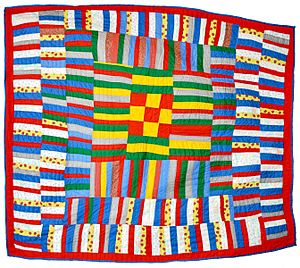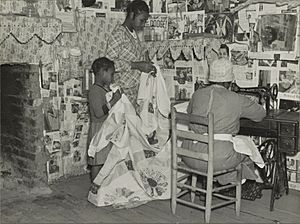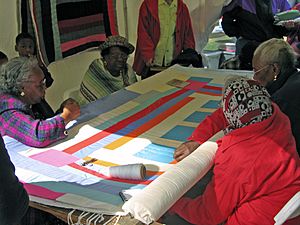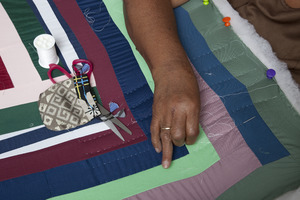Quilts of Gee's Bend facts for kids

The quilts of Gee's Bend are special blankets made by women and their families from a small, isolated community called Gee's Bend, Alabama. This community is located along the Alabama River. These quilts are considered very important works of art and culture from African-American history in the United States.
Famous quilters from Gee's Bend include Arlonzia Pettway, Annie Mae Young, and Mary Lee Bendolph. Many people in Gee's Bend can trace their family history back to enslaved people on the Pettway Plantation. For example, Arlonzia Pettway's grandmother shared stories about her ancestor, Dinah Miller, who arrived in the United States on a slave ship in 1859.
Contents
The Story of Gee's Bend
Gee's Bend, also known as Boykin, is a small, quiet community with about 700 people. It's located southwest of Selma, in a part of Alabama called the Black Belt. The area got its name from Joseph Gee. He was a landowner who started a cotton farm there in 1816 with 17 enslaved people.
In 1845, Mark H. Pettway bought the farm. Many people in the community today still have the last name Pettway. After slavery ended, many freed slaves and their families stayed on the land. They worked as sharecroppers, meaning they farmed the land and shared their crops with the landowner.
Changes and Challenges
In the 1930s, Gee's Bend faced a big problem. A local merchant who had lent money to families died. His family then took away food, animals, tools, and seeds from the people who owed money. The community was saved when the Red Cross provided emergency food.
Later, the federal government bought much of the land. They set up Gee's Bend Farms, Inc. This project helped the community by letting families own their own land. This was very rare for Native and African American people at that time. Famous photographers like Dorothea Lange also visited Gee's Bend. They took pictures for the Farm Security Administration, showing life during the Great Depression.
As farming became more modern, many people left Gee's Bend to find work elsewhere. However, many residents chose to stay. In 1949, a U.S. Post Office opened there.
Isolation and Connection
In 1962, the ferry service, which was one of the only ways to get in and out of Gee's Bend, was stopped. This made the community even more isolated. It also made it harder for residents to register to vote. The ferry service did not start again until 2006.
From the 1960s onward, Gee's Bend and a nearby group called the Freedom Quilting Bee became known for their amazing quilts. A collector named William Arnett helped bring more attention to this art. His Souls Grown Deep Foundation in Atlanta, Georgia organized a big exhibition.
The show, called "The Quilts of Gee's Bend," opened in 2002. It traveled to many places across the country. It featured 60 quilts made by 45 artists. This exhibition made the quilts famous. While there were some disagreements about how the quilts were managed in the past, these issues were later resolved.
Today, Arnett's Souls Grown Deep Foundation continues to support Gee's Bend quilters. They help document their work, market it, and raise money. They also work to get legal rights for the artists' unique designs.
The Amazing Quilts
The tradition of making quilts in Gee's Bend is very old, going back more than 100 years. It might have been influenced by designs from Native American and African textiles. African-American women would sew together strips of fabric to make warm bedcovers.
During the years after the Civil War and into the 20th century, women in Gee's Bend made quilts to keep their families warm. Their homes often did not have heat, running water, phones, or electricity. Over time, they created a unique style. Their quilts are known for being lively, creative, and having simple geometric shapes.
A Unique Art Style
Many Gee's Bend quilts look different from traditional quilts. They have a simple, modern feel. This might be because the community was so isolated. They had to use whatever materials they could find, often recycling old clothes and fabrics.
These quilts have been shown in famous museums around the world. These include the Museum of Fine Arts, Houston, the Whitney Museum of American Art, and the Turner Contemporary in the UK. Art experts have praised the quilts. For example, Alvia Wardlaw, a curator, said their designs are "brilliant" and creative. She compared them to famous 20th-century abstract painters.
In 2002, a review in The New York Times called the quilts "some of the most miraculous works of modern art America has produced." The review even compared them to the art of Matisse and Klee.
The Gee's Bend Collective
In 2003, 50 quilt makers started the Gee's Bend Collective. This group is owned and run by the women of Gee's Bend. Every quilt sold by the Collective is one-of-a-kind.
In recent years, members of the Collective have traveled all over the country. They share the history of Gee's Bend and talk about their art. Many of these women are known for their humor, friendly personalities, and even their singing!
In 2015, Gee's Bend quilters Mary Lee Bendolph, Lucy Mingo, and Loretta Pettway received a special award. It was the National Heritage Fellowship from the National Endowment for the Arts. This is the highest honor the U.S. government gives for folk and traditional arts.
See also




